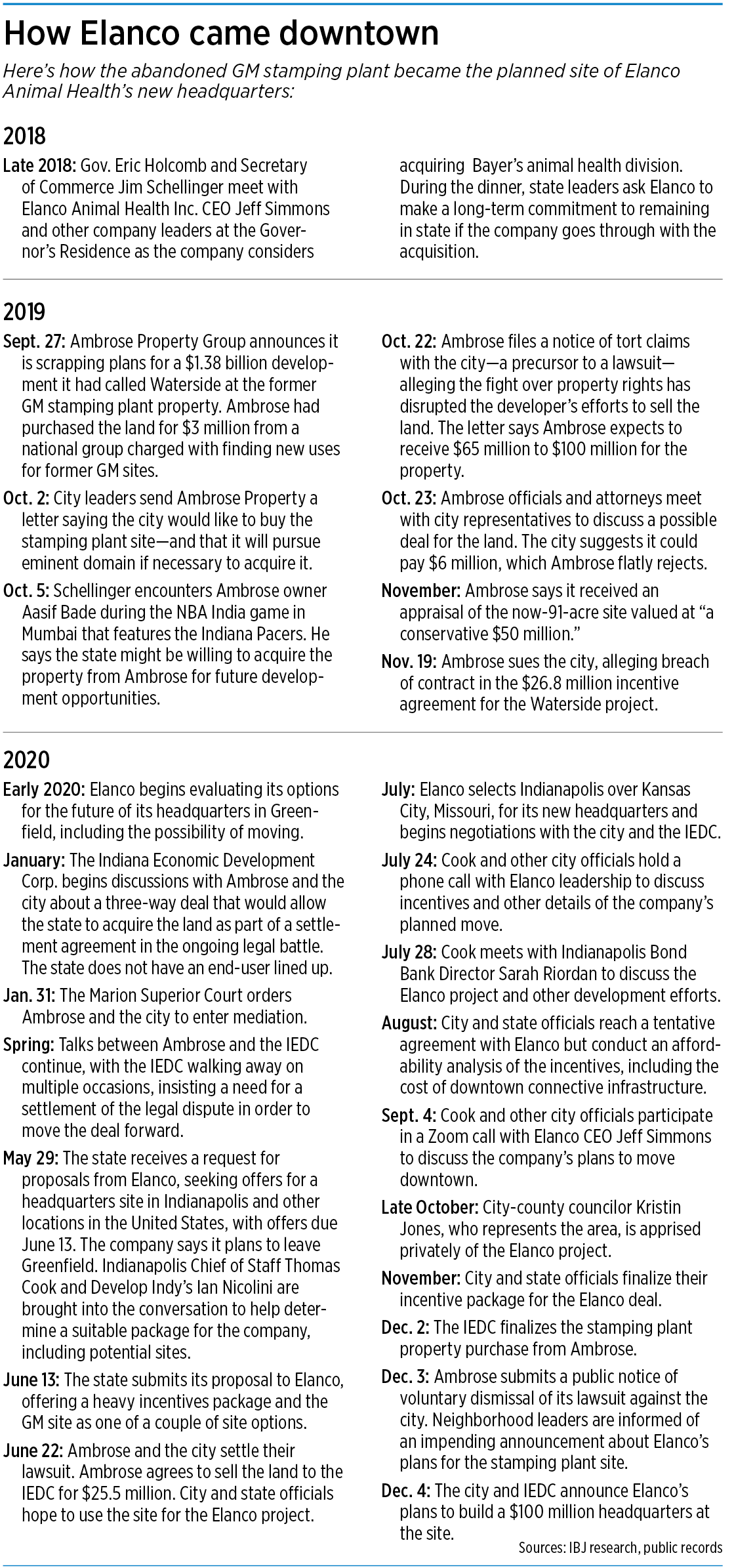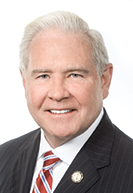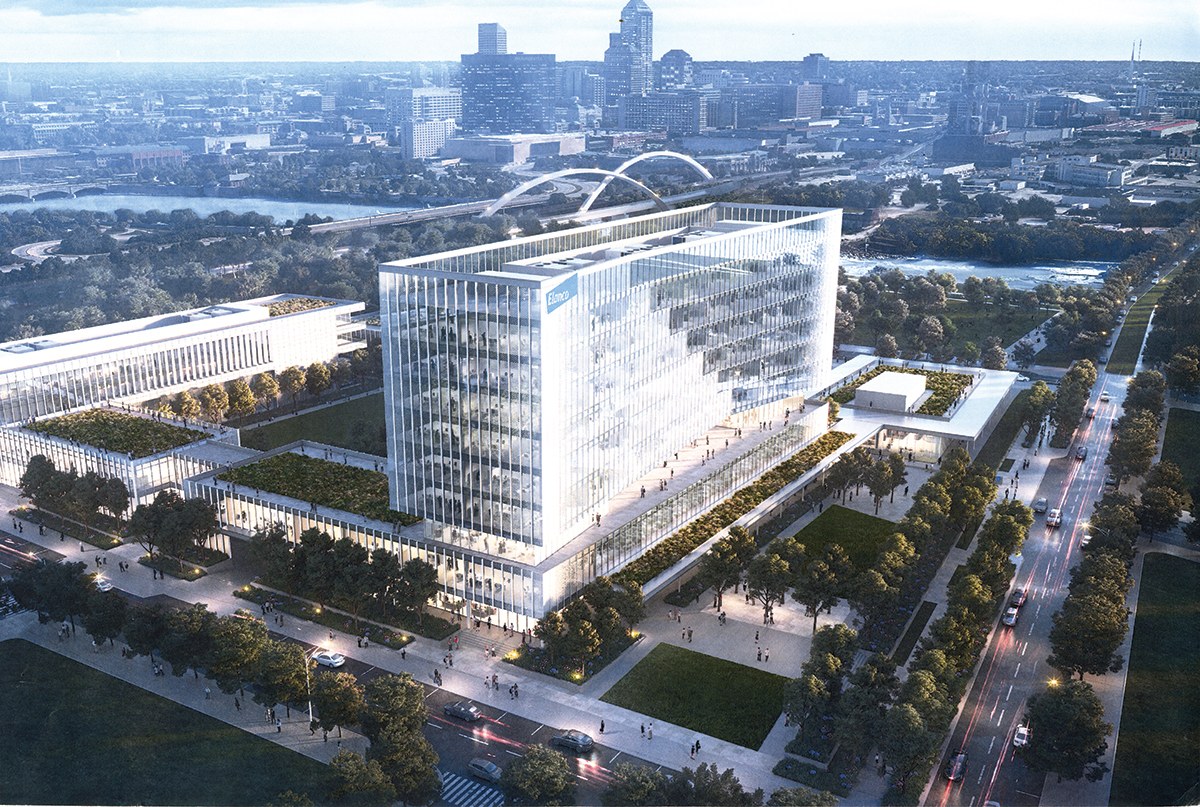Subscriber Benefit
As a subscriber you can listen to articles at work, in the car, or while you work out. Subscribe NowThe state’s pitch to keep Elanco Animal Health Inc. in Indiana for the long term began with a dinner at the Governor’s Residence two years ago, after state officials got wind that the company was considering plans to acquire German conglomerate Bayer AG’s animal health division.

The dinner, attended by Elanco CEO Jeff Simmons and other company leaders, was an opportunity for Gov. Eric Holcomb to offer a full-throated commitment that the state would do whatever it took to keep the company firmly planted in the state for decades to come.
The actual negotiations didn’t begin until more than a year later, as Elanco was preparing this summer to close its $6.9 billion acquisition of Bayer Animal Health and was launching a search for a new headquarters. But when the time came, the state kept its word.
And so, on Dec. 4, Elanco announced it would invest $100 million to develop a headquarters campus on 45 acres at the former GM stamping plant site just west of downtown, a deal made possible by a lucrative incentives package from city and state officials.
In total, the incentives are valued at more than $160 million, with the state providing land for the development that it purchased from Ambrose Property Group. The state said it plans to use the property’s remaining 46 acres for neighborhood redevelopment, an expansion of the White River State Park and potential growth of Elanco’s facilities.
Simmons told IBJ the company was attracted by more than just incentives; it also loved the site.
“What we see as a culture in Indianapolis, what we see we can do on the west side of the river and the western side of Indianapolis—we can be a major player, one of the only players over there,” he said. “That was actually attractive to us.”
But getting the deal done wasn’t easy.

First steps
Indiana Secretary of Commerce Jim Schellinger told IBJ this week that “there were a lot of tentacles” to pulling together the deal with Elanco.

“This was a very, very complex deal—the biggest I’ve ever worked on,” he said.
Schellinger, who attended the Elanco dinner at the Governor’s Residence in 2018, said the deal involved several moving parts, including the state’s procurement of the 91-acre site from Ambrose as well as navigating a legal fight between Ambrose and the city.
Schellinger broached the topic of acquiring the property from Ambrose on Oct. 5, 2019, during a commerce trip to India that included a stop to see the Indiana Pacers play. He spoke briefly about the possibility with Ambrose founder Aasif Bade, who was part of the NBA All-Star 2021 board for the Pacers franchise and part of the entourage attending the games.
He told Bade the state might be interested in acquiring the property—it had also expressed interest in the site in 2018 for Infosys, but that company ultimately went to the old airport terminal site—and was interested in starting talks about the property’s value.
The conversation came just a week after Ambrose announced publicly that it would scrap a $1.4 billion project it had planned for the site, after talks with the city about additional tax incentives for the development fell through.
Schellinger said the state didn’t have a specific plan at that time for the property. “We were just trying to help out,” he said.
By January, the state began talking officially with Ambrose about acquiring the site. But it made clear it wouldn’t do so for the initial asking price of more than $100 million.
That’s in part, Schellinger said, because Ambrose hadn’t invested anywhere near that much to develop the property since buying it for just $3 million from a group charged with finding new uses for former GM properties. A source said the firm spent “millions upon millions” to market and design the Waterside project and property, although they did not offer specifics.

The state still had no plans for a specific use—other than preserving it for future large development opportunities—and had not considered offering it to Elanco.
Meanwhile, the city and Ambrose were still squabbling over the property, which Mayor Joe Hogsett’s administration had threatened to take by eminent domain. That led the firm to sue the city for breach of contract; the sides were beginning court-ordered mediation when the IEDC enlisted the city’s help in buying the land.
“We knew from the very beginning we were going to have to have the support and partnership of the city to make this acquisition work,” Luke Bosso, the Indiana Economic Development Corp.’s chief of staff, told IBJ.
Bosso was among the individuals most heavily involved in the project on the state’s side and helped bring the parties to the table for both the Ambrose property sale and the Elanco headquarter deal.
“One of our initial stipulations in having conversations was that the [Ambrose] lawsuit was going to have to be dismissed,” he said. “We did not want to acquire a property that was ultimately going to still be in litigation.”
In fact, the state stepped away from the negotiations multiple times, in part to try to drive down the price but also to reiterate the importance that Ambrose settle its lawsuit with the city and sell the land with no legal entanglements.

As those talks were ongoing, Ambrose was working with broker Adam Broderick from the Indianapolis office of Chicago-based JLL to also market the property to a wider audience in case the deal with the state fell through. Ambrose hired the brokerage in late 2019 as part of its effort to step away from and sell off the so-called Waterside project and stamping plant land.
Ambrose told the state the site had been appraised for $50 million, and stuck by that figure for a while, Schellinger said.
“Finally,” Schellinger said, “we just said, ‘Here’s the deal: We’re going to give you a purchase [agreement], and this is it for the price. If you want it, fine. If you don’t, that’s fine, too.’”
Ambrose agreed to sell, with the state paying $25.5 million for the property—about one quarter of the amount Ambrose had asked for, but more than what some industry insiders have told IBJ the property is likely worth.

A long summer
Meanwhile, Elanco on May 29 issued a request for cities and states to bid on its headquarters project. Elanco has been mum about what was in the request for proposals, and those who answered it had to sign non-disclosure agreements.
But states and communities that were interested had just two weeks to pull together a proposed incentives package and possible sites.
By then, Elanco—which started taking a hard look at its options in early 2020—had already ruled out staying at its existing headquarters at Progress Park in Greenfield, because it wanted to expand to a more prominent location near an urban center. It hired Indianapolis-based Browning Investments to serve as a real estate adviser and site selection consultant.
So the state brought the city and Develop Indy—the Indy Chamber division that serves as the city’s economic development arm—into discussions on making a bid to land the Elanco headquarters in Indianapolis.
It was during these conversations that the idea of pitching the GM stamping plant site to Elanco came to the fore, Schellinger said. Another site under consideration was on Indianapolis’ northwest side, near the campus of Corteva, formerly known as Dow AgroSciences.
“We looked around at different sites that might fit the bill,” Schellinger said. “And we decided that [the stamping plant] was our number one site. We worked hard, day and night, and we felt like we had a really, really good proposal, and we put it out there.”
City and state leaders met repeatedly throughout the summer to work on the deal, although early in the RFP process, Elanco would deal directly only with Schellinger, leaving other state and city officials working in the background.
They even used code names for the project, something economic development officials often do when trying to keep negotiations a secret. In 2017 and 2018, city officials used the code names Project Wolverine and Project Hazel to refer to work on an ultimately unsuccessful bid for Amazon’s HQ2 project.
The Elanco talks were initially called Peanut Butter, a code name that appears on calendars, obtained by IBJ, of several city officials. That name switched to Meerkat soon after a July 8 meeting called “Operation Meer Butter Fingers” on one calendar.
Sources told IBJ that other communities also bid—and were in the running—particularly Kansas City, Missouri, near which Bayer Animal Health has operations. Bayer’s operations are based in Shawnee, Kansas—about 10 miles southwest.
But in mid-July, Elanco privately selected Indianapolis for the project, leading to continued conversations throughout the summer. City calendars document about 20 Meerkat meetings that included city officials, the IEDC’s Bosso and other entities, including Indianapolis Bond Bank.

Deputy Mayor Thomas Cook also held a meeting with Elanco officials on July 24, as well as a Zoom meeting with Elanco’s Simmons on Sept. 4.
Schellinger said City-County Council President Vop Osili was also involved in the negotiations.
‘The most incredible project’
Although negotiations played out over months, experts said they were surprised by the speed at which the Elanco deal moved. Large economic development deals can take 12 to 24 months to complete.
“It takes a long time—especially if you’re doing a sort of a nationwide or even an international search,” said Lee Lewellen, president and CEO of the Indiana Economic Development Association.
“I think it probably helps that [Elanco] already has a footprint in Indiana and they’re familiar with the state,” he said. “But again, these things usually take multiple years to come together—especially for something of that size.”
The final incentives package includes nearly $90 million in state tax credits, $4 million in training grants, 45 acres of property, and $64 million from the city, largely in the form of infrastructure improvements funded by revenue from a tax-increment-financing district. A TIF district collects tax revenue that is generated by new development to be used for projects generally at the site.
The deal is among the largest in state history.
“Obviously, [this is] the most incredible project we’ve ever worked on, hence our package,” Schellinger said, adding that Elanco did not believe the state’s initial offer was strong enough. “We had to continue to go back and forth, back and forth.”
One distinctive aspect of the Elanco deal is that it focuses as much on retaining jobs as on creating new ones. The company’s agreement with the state requires it to retain 1,600 jobs it already has in Indiana, while creating 573 more, to cash in on all the credits and other incentives.
Schellinger said city and state officials did not want those jobs to leave Indiana, particularly because the company is expected to offer an average annual wage of about $149,000.
“Think about if we’ve lost them, think—if we lost the second-largest animal health care company … in the world,” he said. “This wasn’t staying in Greenfield; we could have not submitted [a bid] and it still wouldn’t have stayed in Greenfield. This project was leaving.”
Although it’s a big investment, experts say it’s no surprise. Multibillion-dollar companies like Elanco are generally given more consideration when it comes to incentives deals, Lewellen and other experts said.
For example, Seattle-based Amazon attracted incentives packages worth billions of dollars from across the United States when it launched its $5 billion HQ2 search in 2017. Some competing cities pledged to rename themselves if the company moved there, while others—including Indianapolis—were willing to put up land, TIF dollars and a variety of tax credits and abatements.

Katie Culp, a partner at Katz Sapper & Miller, an accounting firm that works on economic development deals, said neither the city of Indianapolis nor the IEDC are “free-spending with incentives. They’re very cautious with how they support things from an incentives perspective.”
She said the use of EDGE credits—typically given to firms that create new jobs—to retain the company’s existing workforce is a fairly unusual approach for the state. Elanco is expected to get $51.2 million for job retention, along with another $21.8 million in new-jobs tax credits.
“It is a huge incentives package,” Culp said. “So, for the state to be motivated that powerfully, to put such a large number on the table, tells me that they had to have been truly concerned about losing [Elanco]—perhaps from the state altogether—because it is not something that they do easily or quickly offer up.”
Elanco said in its announcement that, in addition to the $100 million headquarters campus, it plans to invest another $200 million across its Indiana operations, which will include research and technology infrastructure at the new campus.
“The size of this incentive package makes sense given the long-term, transformational impact Elanco’s decision will have on the state, the downtown Indianapolis area, and Indiana’s leadership position in agbiosciences,” IEDC spokesperson Erin Sweitzer said.
The city and state are also hopeful the development will lead to additional investment in the area—and even on the stamping plant property—from suppliers and vendors of Elanco, as well as from other companies that work in the animal health industry.
Last steps
Final project details were ironed out in the weeks before the deal was announced Dec. 4. That includes the city in October telling City-County Councilor Kristin Jones that Elanco would make an announcement soon.
Jones told IBJ this week she still does not have all the details for the project but expects to learn more in the coming weeks. Jones lives in The Valley neighborhood, which includes the stamping plant property, and said that, while the project could be viewed by some as a consolation prize (compared with Ambrose’s $1.4 billion proposal), it shouldn’t be.
She said that plan turned out to be a “pie in the sky” idea that “was never going to happen” after the city and Ambrose failed to come to terms.
“We waited for that for a long time,” she said. “So this [Elanco deal] is what we had, and I think this is what we’re going to move forward with.”
On Dec. 2, the state officially closed on the property, and it expects to transfer the land to Elanco in the coming months.
Ambrose completed its end of the bargain, also on Dec. 2, voluntarily withdrawing its lawsuit against the city.
For its part, Ambrose said in a statement it is focused on other projects moving forward, specifically those in the industrial sector in Indianapolis and elsewhere around the United States.
“We are thrilled with both Elanco and the IEDC’s plans for a new global headquarters at the former GM stamping plant,” the statement said. “We congratulate Elanco, the city of Indianapolis, the state of Indiana, the IEDC and all of those who made this historic investment happen.”
The state incentives for Elanco are expected to go before the State Budget Committee on Dec. 16. A spokesperson for the Mayor’s Office said the city’s legislative process to approve the use of TIF for the project is likely to begin early next year, with the Metropolitan Development Commission and the City-County Council having final say.
Elanco expects to complete construction on its new headquarters no later than 2024•
Please enable JavaScript to view this content.


Bravo!
Such a better outcome than anything previously proposed!
Does anyone know if a date has been set as to when they expect to have the project complete and the office open? …..or am I getting ahead of myself?
Thanks for the question, Patrick. Elanco has indicated it plans to complete project in the “next two to three years.” The tax incentives are for commitments the company has pledged to meet over the next 10 years.
Does anyone know what type of environmental investigation and cleanup work is still needed to prepare the site for development ?
Gary, this is something I’m continuing to look into. More to come on this in the days ahead.
Great to have a project adjacent to downtown and in a disused property. Costs include $90 million in state tax credits and $64 million from the city. Additional costs for roadway development and maintenance are to be borne by city? How will these jobs with relatively high annual wages leverage benefits throughout the regional economy with respects to overall incentives provided by the state and city.